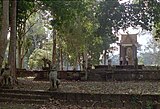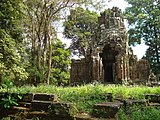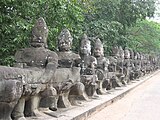Angkor Thom

Angkor Thom (
Etymology
Angkor Thom (
History

Angkor Thom was established as the capital of Jayavarman VII's empire and was the centre of his massive building program. One inscription found in the city refers to Jayavarman as the groom and the city as his bride.[4]: 121
Angkor Thom seems not to be the first Khmer capital on the site, however.
The last temple known to have been constructed in Angkor Thom was Mangalartha, which was dedicated in 1295. Thereafter the existing structures continued to be modified from time to time, but any new creations were in perishable materials and have not survived.
The Ayutthaya Kingdom, led by King Borommarachathirat II, sacked Angkor Thom, forcing the Khmers under Ponhea Yat to relocate their capital southeast to Phnom Penh.[5]: 29
Angkor Thom was abandoned sometime prior to 1609, when an early western visitor wrote of an uninhabited city, "as fantastic as the Atlantis of Plato".[4]: 140 It is believed to have sustained a population of 80,000–150,000 people.
The Poem of Angkor Wat composed in Khmer verse in 1622 describes the beauty of Angkor Thom.
Style
Angkor Thom is in the Bayon style.
The site

The city lies on the west bank of the
The faces on the 23 m towers at the city gates, which are later additions to the main structure, take after those of the Bayon and pose the same problems of interpretation. They may represent the king himself, the
Within the city was a system of canals, through which water flowed from the northeast to the southwest. The bulk of the land enclosed by the walls would have been occupied by the secular buildings of the city, of which nothing remains. This area is now covered by forest.
Most of the great Angkor ruins have vast displays of bas-relief depicting the various gods, goddesses, and other-worldly beings from the mythological stories and epic poems of ancient Hinduism. Mingled with these images are actual known animals, like elephants, snakes, fish, and monkeys, in addition to dragon-like creatures that look like the stylized, elongated serpents (with feet and claws) found in Chinese art.
But among the ruins of Ta Prohm, near a huge stone entrance, one can see that the "roundels on pilasters on the south side of the west entrance are unusual in design."
What one sees are roundels depicting various common animals—pigs, monkeys, water buffaloes, roosters, and snakes. There are no mythological figures among the roundels, so one can reasonably conclude that these figures depict the animals that were commonly seen by the ancient Khmer people in the twelfth century.[9]
Gallery
-
Bayon, the most notable temple at Angkor Thom.
-
Preah Vihear Pram Pi Lvên
-
North Gate
-
South Gate bridge
-
South Gate
-
South Gate moat
-
Western face of the East Gate, also known as the Gate of the Dead
-
Detail of the eastern face of the Gate of the Dead
-
Approach to the Gate of the Dead
-
Royal palace east pond
-
Basin near Phimeanakas
In popular culture
- The Angkor complex is briefly mentioned in the 1933 film King Kong.[10]
- Lara Croft: Tomb Raider features several characters visiting Angkor Thom during their trip to Cambodia to recover the first piece of the Triangle of Light.
- In James Rollins' SIGMA Force Book 4: The Judas Strain (2007), the characters' journey to find a cure for a plague, which requires following in the steps of Marco Polo, leads them to the Angkor Thom.
- In Peter Bourne's novel The Golden Pagans (c.1956), the main characters are sent to Arabia during the Crusades, captured, and forced into servitude by the Khmers. The prisoners build a portion of what becomes known as Angkor Thom.
- In Patlabor the Movie 2, the opening scene appears to be based on the Angkor Thom, as said by Hayao Miyazaki in an interview with the film's director Mamoru Oshii and an Animage interviewer (October 1993).[11]
- In Civilization IV: Beyond the Sword, Angkor Thom is the third city built in the Khmer Empire, after Yasodharapura and Hariharalaya.
- In Eternal Darkness: Sanity's Requiem, Angkor Thom is the region where a Cambodian temple is located, housing the Ancient Mantorok.
- In Civilization VI, Angkor Thom is the capital of the Khmer Empire.
- In The Amazing Race 32, the east gate of Angkor Thom hosted a Pit Stop during the season's tenth episode.[12]
References
Notes
- ISBN 9786167339443
- ISBN 978-0-8248-0368-1.
- ^ word Nokor Thom and Nokor Wat in Khmer dictionary adopted from Khmer dictionary of Buddhist institute of Cambodia, p. 444 and 445, pub. 2007.
- ^ ISBN 1-84212-584-2.
- ^ Chakrabongse, C., 1960, Lords of Life, London: Alvin Redman Limited
- ISSN 0099-9660. Retrieved 2020-03-12.
- ISSN 0914-9783.
- ^ a b c Glaize, Maurice. 2003. English translation of the 1993 French fourth edition. The Monuments of the Angkor Group. Retrieved 14 July 2005.
- ^ a b Freeman, Michael and Jacques, Claude 1997. Angkor Cities and Temples. Bangkok: River Books.
- ^ "Springfield! Springfield!".
- ^ "Around the movie Patlabor 2: To put an end to the Era". Japan: Tokuma Shoten. October 1993.
- ^ Turano, Sammi (2 December 2020). "The Amazing Race Recap for 12/2/2020: The Final Five Compete". TV Grapevine. Retrieved 3 December 2020.
Bibliography
- Albanese, Marilia (2006). The Treasures of Angkor (Paperback). Vercelli: White Star Publishers. ISBN 88-544-0117-X.
- Freeman, Michael; Jacques, Claude (2003). Ancient Angkor (Paperback). Bangkok: River Books. ISBN 974-8225-27-5.
- Jessup, Helen Ibbitson; Brukoff, Barry (2011). Temples of Cambodia – The Heart of Angkor (Hardback). Bangkok: River Books. ISBN 978-616-7339-10-8.
External links
 Geographic data related to Angkor Thom at OpenStreetMap
Geographic data related to Angkor Thom at OpenStreetMap Media related to Angkor Thom at Wikimedia Commons
Media related to Angkor Thom at Wikimedia Commons






















